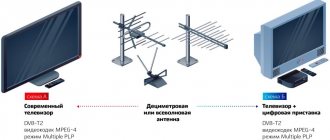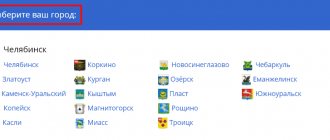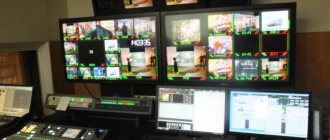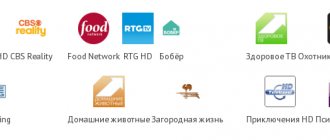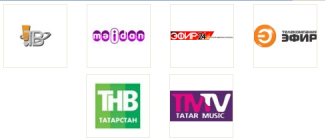From April 15, 2021, the Lipetsk region is switching to digital TV broadcasting!
Digital television
On April 15, 2021, the Lipetsk region will switch to digital television broadcasting.
Digital television means higher quality image and sound.
01. When and to whom will analogue broadcasting be turned off?
Russia is switching from analogue to digital television signals. This will improve the quality of image and sound, as well as increase the number of free channels to 20.
The transition to digital broadcasting will not affect those who have cable, satellite or Internet television - they already have digital broadcasting.
Those who watch TV through an antenna, in some cases need to prepare in advance to receive a digital signal. Otherwise, after turning off analogue broadcasting, their TVs will stop showing.
02. How can I tell if my television will be turned off or not?
Turn on the main central channels - Channel One, Rossiya 1, NTV, Channel Five, REN-TV, STS, TNT, Zvezda, TVC and others.
If you see the letter “A” next to the logos, then you have analog television, and you need to perform a number of actions (see point 03) so that your TV can receive a digital signal.
If there is no "A" next to the logo, after April 15 you will continue to watch TV as before.
Please note that if you have multiple TVs in your home, they may receive TV signals in different ways. For example, in the living room the TV is connected to cable TV, and in the kitchen the reception is via an antenna.
03. How to set up digital if I watch TV through an antenna?
If you have analog television (there is a letter “A” next to the central channel logo), find out whether your TV supports the DVB-T2 standard.
Digital TVs released after 2012 mostly have a built-in corresponding decoder; those released earlier may not support this format. Old analog TVs do not support the required standard.
You can check whether your TV supports the DVB-T2 standard in the instructions for the TV or using the “Search for information about TV” service (https://lipetsk.rtrs.ru/tv/connect/) on the website of the Russian Television and Radio Broadcasting Network ( RTRS). You will only need to enter the make and model of your TV.
If your TV supports DVB-T2, you just need to set up your TV using the remote control:
STEP 1.
Go to the appropriate section of the TV settings menu and activate the digital tuner.
STEP 2.
Perform an automatic search for programs using the operating instructions. You can perform a manual channel search. In this case, you must enter the channel number or frequency.
If your TV does not support the DVB-T2 format, you need to purchase additional equipment - a digital set-top box (receiver):
If you have two TVs that you watch through an antenna, and you want to watch different channels on them, you need to purchase a set-top box for each of them.
The digital set-top box needs to be connected to the TV and configured:
STEP 1.
Turn off the TV's power.
STEP 2.
Connect the antenna cable to the antenna input of the digital set-top box.
Connect the video and audio cables to the appropriate jacks on your TV and digital set-top box. The image quality will be higher when connecting the set-top box to the TV with an HDMI cable.
STEP 3.
Connect the power supply and turn on the TV.
STEP 4.
In the menu, select the required input source: HDMI, AV, SCART and others.
STEP 5.
Automatically search for digital TV programs using the operating instructions. You can perform a manual search. In this case, you must enter the channel number or frequency.
You can find more information on how to connect digital TV, choose a digital set-top box, where to buy it and how to set it up on the website smotritsitru.rf (https://lipetsk.rtrs.ru/tv/connect/)
04. What channels will be available to me after switching to digital TV?
If you watch television through an antenna, after switching to a digital signal, you will have access to 20 mandatory free TV channels of the first and second multiplexes.
The first multiplex includes: Channel One, Rossiya 1, Match TV, NTV, Petersburg - Channel Five, Culture, Rossi 24, Karusel, OTR, TV Center - Moscow.
The second multiplex includes: REN, Spas, STS, Domashny, TV-3, Friday!, Zvezda, Mir, TNT, Muz-TV.
05. I still have questions. Where to go?
You can find all the information about the transition to digital terrestrial television on the website of the Russian television and radio broadcasting network smotritsifru.rf (https://lipetsk.rtrs.ru/tv/connect/) or consult RTRS specialists by calling the toll-free federal hotline.
You can contact the Advisory Support Center at the address: Lipetsk, Pobeda Square, 6 or call there by phone.
You can also call the Unified Contact Center of the Administration of the Lipetsk Region 8-800-450-48-48.
Video instructions for troubleshooting:
Digital terrestrial television DVB-T2
Digital terrestrial television
is a fundamentally new broadcasting format, the technical features of which have made it possible to significantly improve the characteristics of the signal and, as a result, image and sound. The era of new television in Russia began in 2009, and since then the coverage area has increased by 76%, and the number of broadcast channels has grown from 5 to 20.
Fundamental differences between advanced technologies
Digital TV DVB-T2
, compared to analogue broadcasting, has a number of undeniable advantages:
- No subscription fee
. Digital broadcasting is absolutely free, and unlike satellite or cable television. - Easy to install
. The simplest setup method allows you to connect and configure broadcasting yourself in a matter of minutes. - Minimum equipment
. To receive a digital signal, a modern TV with a built-in tuner or an additional set-top box – a receiver – is sufficient. - Picture and sound quality
. Clear and surround sound, as well as contrasting images in MPEG4 format. - Number of channels
. Today there are 20 main channels, but their number is increasing every year. - Additional services
. With the help of digital, several government programs are being implemented: prompt notification of the population in case of emergencies, access to Electronic Government, etc.
Opportunities for subscribers
The implementation of a modern broadcasting system has made it possible to receive terrestrial digital television channels
even in moving objects - cars, ships, etc.
The transmitted signal is sufficient to ensure a stable image without interference due to the use of a more powerful antenna and an ordinary receiver as equipment. Also, digital reception
today is implemented in laptops and desktop computers using USB tuners. Such devices provide the ability to record and process video.
DVB-T2
broadcast over an extensive network of ground-based equipment using cutting-edge satellites, which made it possible to increase the access area to a level of 99.7%. The level of digital television coverage in Russia is growing every day. The number of channels and the possibility of broadcasting them is increasing even in the most remote corners of the country.
List of digital terrestrial TV channels in Lipetsk
The first multiplex in Lipetsk:
- First
- Russia 1
- MatchTV
- NTV
- Channel 5
- Russia Culture
- Russia 24
- Carousel
- Public television of Russia
- TV Center
Second multiplex in Lipetsk:
- REN TV
- SAVED
- STS
- Home
- TV3
- Friday
- Star
- WORLD
- TNT
- Muz TV
LipSat is a reliable partner that will allow you to follow progress. Today you have the opportunity to connect terrestrial digital television in Lipetsk
and enjoy the impeccable quality of the channels!
How to easily connect to digital TV
Less than four months remain until a large-scale technological breakthrough in the system of mass communications in the Lipetsk region. Starting from January, the region will completely switch from regular analogue to digital terrestrial television broadcasting, including two multiplexes with 10 channels each.
“With the advent of the digital network, Lipetsk residents will receive high-quality television broadcasting absolutely free of charge in a volume comparable to what was previously offered only in paid packages,” Viktor Protopopov, director of the regional radio and television transmission center, told LipetskMedia.
Why was a new broadcast distribution standard required? Without going into technical details, this question can be answered like this:
Firstly, the digital signal has higher noise immunity, which ensures excellent image and sound quality regardless of weather conditions.
Secondly, instead of one “analog” program in the same frequency band, you can transmit a dozen digital ones, and also use groups of transmitters operating on a single frequency.
Thirdly, the digital standard provides numerous additional features, such as viewing schedules and current information about TV programs, recording them or watching them later, teletext, age restrictions functions, and so on.
However, only new generation TVs manufactured after 2015 can receive a digital stream of the T2 standard. But what about those who still use the old ones? For them you need to buy special attachments.
— These consoles are mainly imported to Lipetsk from China. Some of them are factory-made, others are basement-made. Therefore, you need to be very vigilant when choosing a purchase,” Tatyana Kazakova, manager of the regional Center for Communication Support of Digital Terrestrial Television, warned LipetskMedia.
According to her, set-top boxes should only be purchased in specialized departments for the sale of electronic and household appliances in well-known Lipetsk shopping centers. And not in small shops or at the market. The warranty period should be at least a year, and the cost should be from 1,200 to 2,500 rubles. A guarantee of several months and a price of 600 or a little more rubles should immediately alert you.
Not only that... Before purchasing, you also need to find out what cable inputs your TV has. They are different. “Tulips”, “starts” and others. The easiest way to avoid mistakes is to write down the TV model number indicated on its back cover. Using this number, the manager of the electronics department will select a wire with the required connector.
But that's not all. It is necessary to check in the service area of which digital repeater of the Lipetsk region your locality is located by calling the specialists of the Advisory Support Center by phone.
Also ask about the frequencies on which the broadcast is made. If the antenna is not aimed at the nearest repeater, or the receiver “captures” the frequency of the neighboring zone, reception stability is not guaranteed.
You also need to choose the right receiving antenna. It is better if it is passive, that is, without an amplifier. The passport must indicate the range 21-60 TVK.
The digital broadcasting network is designed for reliable reception throughout the Lipetsk region, so in the vast majority of cases antenna amplifiers are not needed. If an amplifier is still available, the reception stability will be increased by the GSM filter, which suppresses interfering signals from mobile operator base stations. In this case, the antenna itself should look like in the figure.
Tatyana Kazakova warned LipetskMedia that scammers selling antennas have appeared in the Lipetsk region. In rural areas, they advertise cheap indoor antennas that will supposedly receive a digital signal without set-top boxes on old TVs. This is a lie.
For technically advanced young people, it will be easy to buy the necessary set-top boxes and antennas, as well as connect to digital television on their own. For the older generation, just in case, it wouldn’t hurt to look at the website digital48.rf and carefully read the recommendations of experts.
Victor Kamsky
Third multiplex
The third digital television multiplex of Russia in its original version assumed the presence of one HD channel, one regional channel from VGTRK and regional channels belonging to different regions.
Broadcasting of the third multiplex will be carried out by FSUE RTRS in the DVB-T2 standard throughout Russia on the principles approved by the meeting of the Government Commission for the Development of Television and Radio Broadcasting on December 17, 2010. The third multiplex is formed from:
- from 4 regional TV channels in standard definition format (SDTV)
- one federal all-Russian TV channel in high definition format (HDTV).
The channels were to be determined on a competitive basis. Regional TV and radio companies participating in the competition can attract federal television and radio broadcasting organizations that are not included in the second multiplex as network partners.
Basic principles when selecting channels for the third multiplex:
- 24-hour broadcasting;
- broadcasting concept;
- availability of a larger volume of own-produced and/or purchased programs;
- degree of interest in the TV channel;
- financial position of the company;
- availability of current broadcasting in the analogue standard;
- social significance of the channel.
However, now the concept has changed and the third Russian digital television multiplex will include channels that could not enter the first two. Thus, the following channels can apply for inclusion in the third multiplex: Dozhd, Russia Today, Friday, 2×2 and others. The final decision on the third multiplex will be made by a government commission.
At the SPECTRUM-2013 conference, details about the third digital television multiplex were announced. According to a representative of RTRS, the third multiplex will be predominantly federal. The preliminary plan for its composition is 10 standard definition (SD) channels, 7-8 federal, 1-2 regional and one channel will be transferred to VGTRK. There are no plans for high definition (HD) channels in the third digital TV multiplex in Russia.
So far, one channel has been identified, which will be included in the third multiplex. It will be a TV channel created by branches of the Federal State Unitary Enterprise VGTRK for each specific subject of the Russian Federation. The television channel will be formed under a single brand and comply with the information policy of VGTRK. In regions where there are no large branches of the Federal State Unitary Enterprise VGTRK or where it is not possible to form a channel with the help of VGTRK, local regional TV channels can be involved in broadcasting.
It is not yet clear when the third multiplex will be launched, but according to the stated plan of the Russian government for the transition to digital television, its launch should take place before the end of 2015.
At this stage of development of digital terrestrial TV 3 multiplex is already broadcast in Moscow
It includes the first and second all-Russian channels broadcast in the high definition HDTV standard, as well as the following channels: RU TV, CTC love, RBC, Moscow 24, and two local channels.


